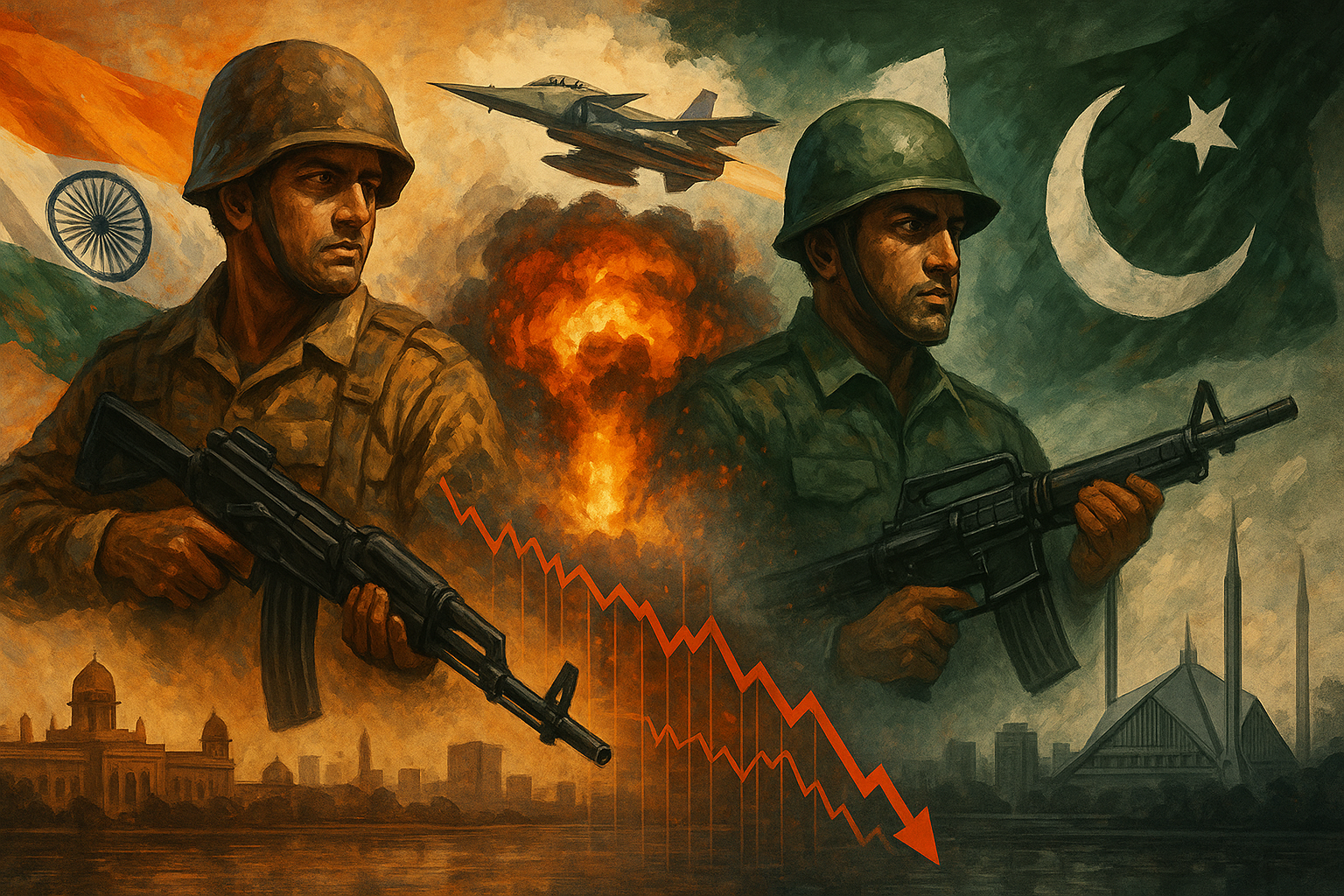Snapshot of the past 48 hours
What happened?
- Early 7 May (local time) India’s air force executed Operation Sindoor, hitting nine sites it calls “terrorist infrastructure” in Pakistan and Pakistan-administered Kashmir. New Delhi says the strikes answer the 22 April Pahalgam massacre of 26 Hindu tourists. Islamabad insists civilian sites were struck, reporting at least eight dead and 35 injured and branding the raid an “act of war”. Shelling along the Line of Control (LoC) has since killed three Indian and an unknown number of Pakistani civilians.(Reuters, Al Jazeera, The Guardian, Xinhua News, Latest news & breaking headlines)
- 7 May afternoon: Pakistan claims it downed an Indian jet and has “commenced measured retaliation”. Both sides have activated hotlines; the 2021 LoC cease-fire is effectively suspended. World leaders—from the UN Secretary-General and the US President to Beijing and Tokyo—have urged restraint, underscoring the nuclear risk.(Reuters, Al Jazeera)
Immediate economic reverberations
| Indicator | Latest move | Drivers & outlook |
|---|---|---|
| Indian rupee (1-month NDF) | slumped to ₹ 84.65 /$ | Flight to safety; RBI expected to sell dollars to cap volatility.(Reuters) |
| Pakistan KSE-100 | −3.4 % intraday | Foreign outflows and fears of IMF delays.(Bloomberg) |
| Moody’s guidance | India 2025 GDP cut to 6.3 %; Pakistan warned of slower recovery and tighter external financing | Higher defence outlays, potential export disruptions, pressure on FX reserves.(The Economic Times, Dawn) |
Take-away: India’s $3.7 trn economy is large and insulated, so the hit is likely a temporary sentiment blip unless the conflict widens. Pakistan’s $370 bn economy—already in an IMF programme—has far less shock-absorbing capacity; even a short crisis can tighten dollar liquidity, lift inflation and slow reforms.
Political and strategic trajectory (next 1–4 weeks)
| Scenario | Probability | Rationale |
|---|---|---|
| Controlled escalation (artillery duels, limited air/missile tit-for-tat, then back-channel de-escalation) | ≈60 % | Both militaries signal “punishment but not war”; external pressure high; 2019 Balakot precedent. |
| Diplomatic freeze but no further strikes | 25 % | Each side claims victory domestically; UNSC & Gulf mediators broker quiet pause. |
| Run-away escalation (extended air campaigns or major ground incursion) | 15 % | Accidental civilian mass casualties or misread signals could override caution. Nuclear threshold still a brake. |
(Assessments draw on Atlantic Council expert polling and recent crisis patterns.)(Atlantic Council)
Human cost and social fallout
- Civilian deaths, power cuts in Muzaffarabad and border districts, and temporary closure of at least 900 schools on both sides of the LoC.
- Tourism, trucking and small-scale cross-LoC trade—worth roughly $160 m a year—have halted. Rural households that rely on seasonal labour migration across the frontier are hardest hit.(The Guardian, Al Jazeera)
- Both governments face nationalist pressure; social-media disinformation is spiking, increasing communal tensions in Indian states adjoining Pakistan.
Steps to de-escalate & rebuild trust
| Track | Concrete actions (next 30 days) | Stakeholders |
|---|---|---|
| Military-to-military | Re-activate 2003 DGMO hotline, resume weekly LoC flag meetings, verify no troop build-ups within 5 km of the LoC via UAV imagery shared with UNMOGIP. | Indian & Pakistani Defence Ministries, UNMOGIP |
| Diplomatic | Convene a “Kashmir humanitarian corridor” working group under OIC + UAE facilitators; parallel US-EU quiet shuttle diplomacy to cap missile deployments <100 km from border. | MEA (India), MoFA (Pakistan), UAE FM, US State Dept. |
| Economic confidence-building | ◦ Reopen Wagah–Attari road for perishables; ◦ Fast-track Indus Waters Treaty joint inspection postponed since 2023; ◦ Announce synchronized tariff suspension on 15 essential medicines. | Commerce ministries, World Bank IWT office |
| Civil society | Fund joint media literacy initiatives to curb hate speech; resume medical visas and cultural exchanges started in 2018. | NGOs, diaspora networks, UNESCO |
Calling the Modi government to account—professionally
- Evidence-based scrutiny: Demand publication of satellite and HUMINT justifying target selection and civilian harm assessments. Independent Indian think-tanks, opposition MPs and the Comptroller & Auditor General can file RTI (Right to Information) requests and seek a parliamentary defence-committee hearing.
- Judicial oversight: Public-interest litigations in India’s Supreme Court can test the strikes against Article 21 (right to life) and require an ex-post proportionality review, as the court ordered after the 2019 Balakot strikes.
- Media & diaspora advocacy: Encourage Indian and global outlets to run data-driven casualty audits (similar to the Guardian casualty tracker for Gaza) and amplify testimonies from Kashmiri civilians. Fact-checking alliances should flag unverified official claims in real time.
- Investor and ESG pressure: International funds applying UN-PRI standards can question Indian sovereign-bond issuances on conflict-risk grounds, nudging New Delhi to articulate a clear exit strategy.
- Multilateral leverage: The UN Human Rights Council’s Universal Periodic Review (UPR) of India is due in 2026; preparatory NGO submissions this year can document any civilian-protection lapses, keeping the issue on the agenda without broad-brush sanctions that typically harden nationalist postures.
Bottom line
The crisis remains in a dangerous but containable phase. Markets are already pricing in a quick cooling-off, yet a single mis-step could impose heavy economic and human costs—far costlier for Pakistan but still a drag on India’s growth narrative. Immediate transparency, robust third-party mediation and revived cross-border economic linkages are the most plausible off-ramps. Sustained civil-society and institutional checks—inside India and abroad—are essential for holding the Modi administration to its rhetoric of “measured, non-escalatory” action and for ensuring that this latest flashpoint does not become the fuse for a broader South Asian crisis.

